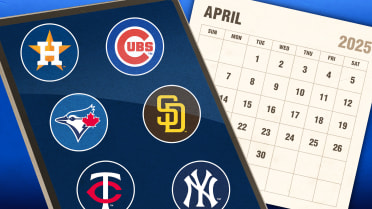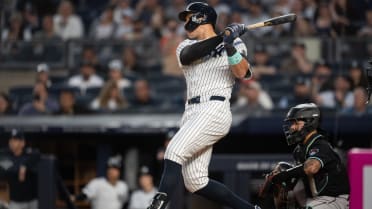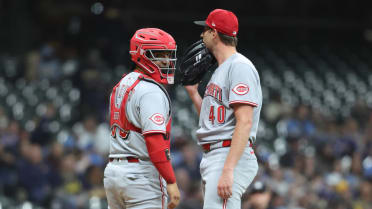With Giancarlo Stanton and Aaron Judge set to become Yankees teammates, fans in the Bronx should be treated to some truly dazzling displays of power at Yankee Stadium in 2018.
The Yankees reached an agreement to acquire Stanton from the Marlins on Saturday, according to MLB.com sources, which would unite the reigning American and National League home run champions for just the fourth time in Major League history. Now that Stanton looks to be coming to New York, the big question is: How will his power play in Yankee Stadium?
Thanks to Statcast™, we can try to answer that question. Using tracking data for Stanton in 2017, we can take all his potential home runs in Miami -- his batted balls at Marlins Park with projected distances of at least 300 feet -- and extrapolate how his home run total might have changed if he had played in Yankee Stadium.
It just so happens, based on the trajectories of Stanton's potential homers and the field dimensions and wall height of Yankee Stadium, the answer to the question "How would Stanton look playing 81 games in the Bronx?" appears to be: Essentially the same. And the Yankees would certainly take more of the same from Stanton.
Stanton hit 31 of his 59 home runs at Marlins Park in 2017. In Yankee Stadium, the Statcast™ data suggests he would have hit … 31 home runs. Note that this comparison doesn't consider the specific conditions at each stadium -- so it's possible that some of Stanton's fly balls that didn't carry at Marlins Park, with its retractable roof and operable back wall in left field, would travel farther on the right day in New York, potentially producing an extra homer here or there for the NL MVP.
But based solely on the actual trajectories of his deep flies at Marlins Park, Stanton wouldn't have gained or lost a single home run if he had been in the Bombers' ballpark instead. The same 31 home runs he hit in Miami, he would have hit in New York.
The reason for that: Stanton's batted ball profile. Most of Stanton's home runs are driven to the pull side of the field. Often, they are simply crushed. When he turns his 6-foot-6, 245-pound frame into a pitch, he's usually sending the baseball a long way. Stanton hit 25 homers to left or left-center at Marlins Park in 2017, and those had an average distance of 425 feet. Ten of them had a projected distance of at least 440 feet.
Additionally, in left and center, Yankee Stadium's fence dimensions are pretty similar to those of Marlins Park. There is a section in left-center where the Yankee Stadium fence is deeper -- but the Marlins Park wall is higher, which resulted in a few impressive leaping catches against Stanton this season.
Those balls didn't have the height to clear the taller Marlins Park wall, and they wouldn't have had the distance to clear the deeper Yankee Stadium wall.
Of course, the key area of interest is the short porch in right field in the Bronx. But only six of Stanton's 31 long balls at home went to right field in 2017. They would, of course, have been gone at Yankee Stadium. But Stanton only hit a smattering of "air balls" (fly balls and line drives) that way, and even the short porch wouldn't have turned any of those into homers.
For a right-handed hitter with heavier opposite-field tendencies, the shallow right-field fence in the Bronx might be a bigger boost -- someone like J.D. Martinez, whose 19 opposite-field homers led the Majors in 2017. But maybe the most relevant comparison is to Judge, Stanton's fellow behemoth in pinstripes.
• Stanton's only home run at Yankee Stadium was an absolute laser beam
The biggest danger in Stanton's game comes from his pull power. He lays into a lot more balls to left than he pops out to right. But Judge's ability to stay back on a pitch and use his strength to take it deep to right field is one of the factors that made him so dangerous in his breakout season -- and especially at Yankee Stadium.
Judge had the second-most opposite-field homers in baseball last season, 16, and 12 of those came at Yankee Stadium. That's double the number Stanton hit out the opposite way at Marlins Park, and a full 36.4 percent of the 33 home runs he hit at home. Stanton's opposite-field home run rate at home was 19.4 percent.
For two hitters who are so similar in stature, Judge and Stanton's spray charts differ significantly, especially when it comes to their home run power. On the season overall, Judge hit 30.8 percent of his home runs to right field; Stanton hit just 11 of his 59 to right, 18.6 percent.
Judge is the kind of hitter much more likely to benefit from playing at Yankee Stadium. Stanton isn't -- but that's no knock on the big slugger, because he isn't hurt by Yankee Stadium, either. If Stanton replicated his power production exactly at a new ballpark in 2018, he'd be headed for another monster home run total. The Yankees would be getting another MVP-caliber season.
David Adler is a reporter for MLB.com based in New York. Follow him on Twitter at @_dadler.



